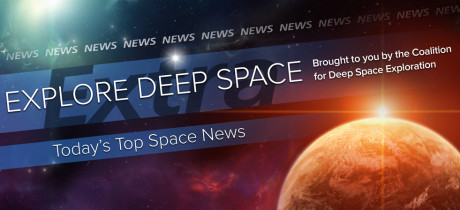In Today’s Deep Space Extra… SpaceX announces plans to send two passengers to the moon and back before the end of next year. NASA continues to examine the risks and benefits of adding astronauts to the EM-1 mission.
Human Deep Space Exploration
SpaceX plans to send 2 tourists around Moon in 2018
The New York Times (2/27): SpaceX announces plans to send two tourists around the moon and back to Earth before the end of next year. The two passengers would spend about a week inside one of SpaceX’s Dragon 2 capsules, launched on SpaceX’s Falcon Heavy rocket. The announcement spurred responses from industry observers, including Executive Director of the Coalition for Deep Space Exploration Dr. Mary Lynne Dittmar, wondering whether the company will be able to pull it off as quickly as Elon Musk has indicated.
The risks and benefits of accelerating crewed SLS missions
The Space Review (2/27): NASA may have influenced a White House call for the agency to examine the risks and advantages of accelerating the launch of astronauts aboard the first joint test mission of the Space Launch System heavy lift rocket and Orion crew capsule, writes TSR editor Jeff Foust. Both the rocket and capsule are cornerstones of the agency’s plans to revive human deep space exploration. Exploration Mission-1 (EM-1) was planned by NASA for late 2018 and is to send Orion around the moon without crew. Bill Gerstenmaier, NASA associate administrator for human exploration and operations, and his deputy, Bill Hill, are leading an effort to weigh the risks and advantages of adding two astronauts. Previously, the agency planned to include astronauts on the second test flight, Exploration Mission-2, planned for late 2021. NASA Acting Administrator Robert Lightfoot announced the possible EM-1 change in mid-February.
House vote on NASA Authorization Bill delayed
Spacepolicyonline.com (2/27): The NASA Transition Authorization Act of 2017, on the U.S. House calendar for passage on Monday, was instead delayed. Potential issues include plans for NASA to cede its low Earth orbit space station needs to commercial providers; indemnification for commercial transportation services providers during risky launch and re-entry activities on NASA’s behalf and the handling of space technology investments, according to the report.
The status of Russia’s human spaceflight program (part 2)
The Space Review (2/27): Visions of reaching the moon with human explorers have splintered in Russia, largely in response to an ailing economy and an infrastructure not yet prepared to support such a venture. Still the country’s leadership has found it impossible to give up on the idea that Russia cosmonauts will make their way to the moon, perhaps in the 2030s, and likely after robotic missions designed to identify resources and sites for a lunar base, writes Bart Hendrickx, a long time Russian space program observer.
Space Science
Does Pluto have the ingredients for life?
Space.com (2/27): Data from NASA’s New Horizons Pluto fly-by mission reveal the distant Kuiper Belt object to be more complex chemically than first thought. They hint at an astrobiological potential. New Horizons, launched in early 2006, carried out the first close fly-by of the dwarf planet in July 2015. Data from the fly-by completed its transmission to Earth in October.
NASA’s flyby of Europa mission begins design phase
Spaceflight Insider (2/27): Plans for a future NASA mission to study the Jovian moon Europa with a spacecraft in orbit around Jupiter have reached a development milestone in preparations for a launch in the 2020s. Europa is believed to host an ice covered ocean. Observations with the Hubble Space Telescope have spotted geyser like plumes rising from Europa’s South Pole. Findings so far suggest Europa may have a habitable environment.
We’re on the verge of a gravitational wave astronomy boom
Seeker.com (2/27): LISA, a space-based observatory for gravitational waves, could be launched by 2029, two years ahead of schedule. LISA Pathfinder, a European Space Agency mission launched in late 2015, is paving the way. The first gravitational wave detection, a phenomenon predicted by Albert Einstein, was made last year with the ground-based Laser Interferometer Gravitational-Wave Observatory, or LIGO observatory. LIGO succeeded in detecting waves generated by the merger of two large black holes.
Historic supernova explosion still shines bright after 30 years
Space.com (2/27): Three decades ago supernova 1987A gave Earthly astronomers their closest look at an exploding star. Just 160,000 light years away in the Large Magellanic Cloud, 1987A is now the most studied star explosion ever.
Commercial to Low Earth Orbit
NASA signs agreement with Boeing for Soyuz seats
Space News (2/28): Under a $373.5 million agreement with Boeing, NASA expects to increase the number of astronauts living and working aboard the International Space Station’s U.S. segment from three to four this year. The agreement will also ensure that NASA can staff the Space Station with astronauts if it counters further delays in its Commercial Crew Program agreements with Boeing and SpaceX. The two U.S. companies are to begin transporting astronauts to and from the Space Station by late 2018. But they could be delayed, the U.S. Government Accountability Office recently cautioned. Russia’s Soyuz has been the only means of launching astronauts to the Station since NASA’s shuttle was retired in 2011.
Earth’s orbiting junkyard threatens the space economy
Bloomberg (2/27): Growing amounts of Earth-orbiting debris are challenging the resources of those who track it. One California start up, LeoLabs Inc., will attempt to help solve the problem commercially by predicting which satellites could be in danger of an impact and when.

